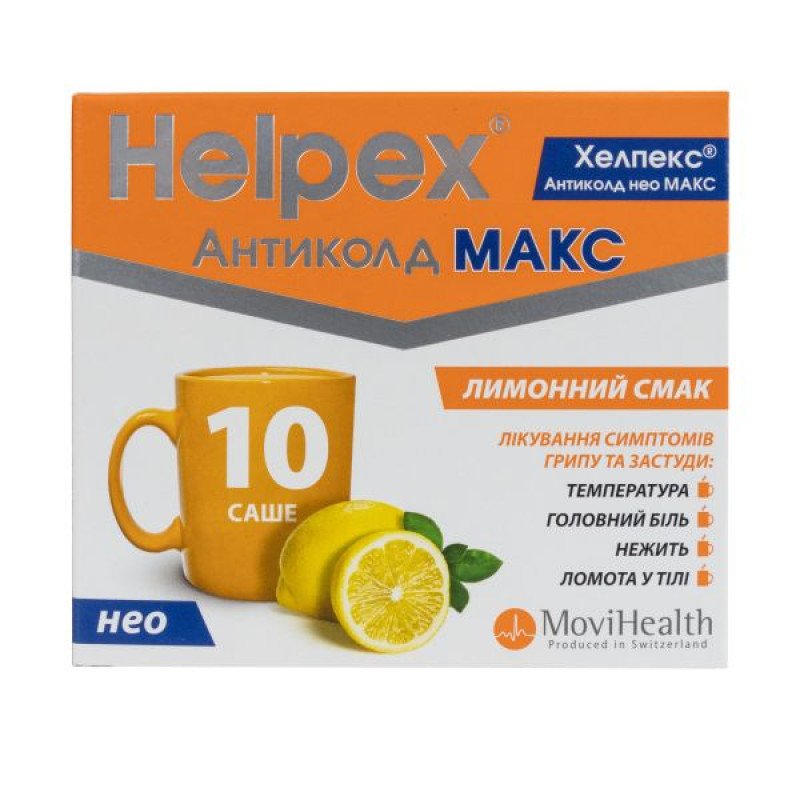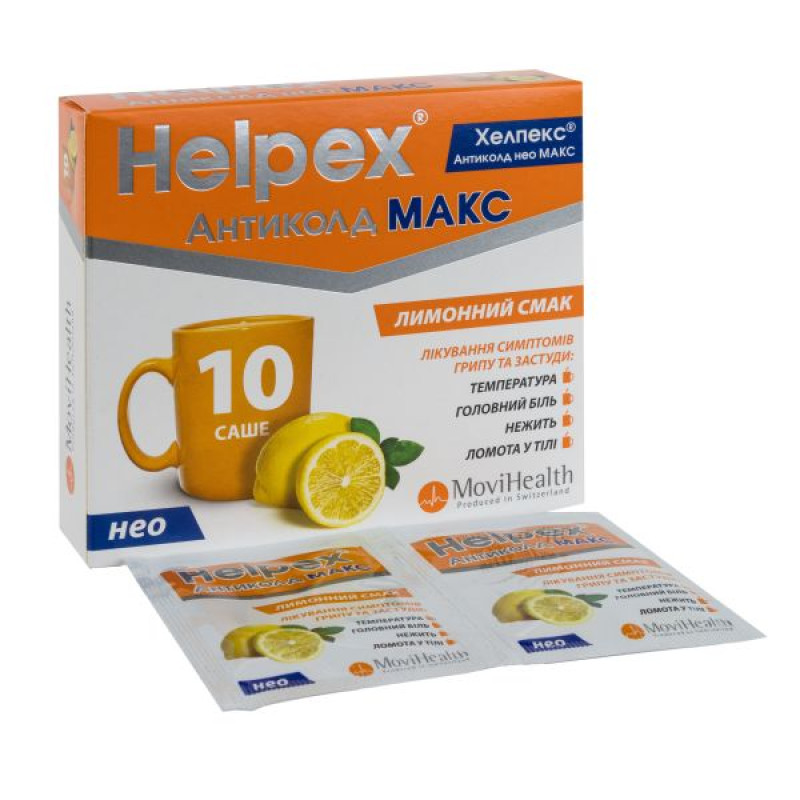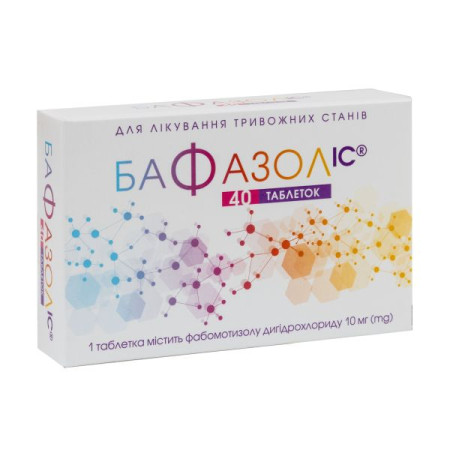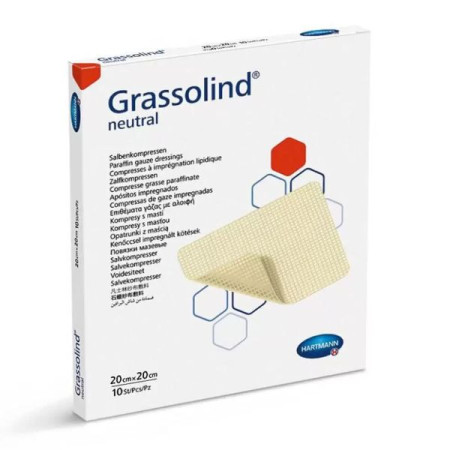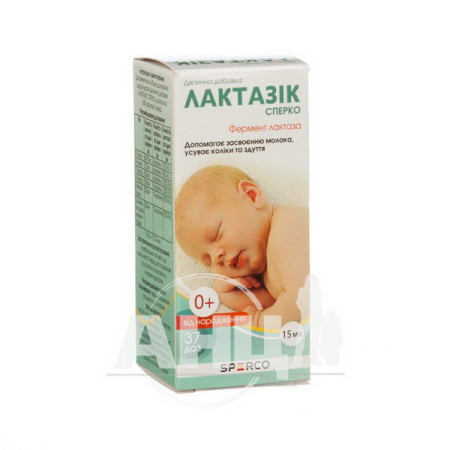Helpex Anticold Neo Max powder for oral solution 4 g sachet with lemon flavor No. 10

Instructions for Helpex Anticold Neo Max powder for oral solution 4 g sachet with lemon flavor No. 10
Composition
active ingredients: paracetamol, levocetirizine dihydrochloride, phenylephrine hydrochloride;
1 sachet of 4 g contains paracetamol 650 mg, phenylephrine hydrochloride 10 mg, levocetirizine dihydrochloride 1.25 mg;
excipients:
"Helpex® Anticold neo MAX" with lemon flavor: colloidal anhydrous silicon dioxide, aspartame (E 951), mannitol (E 421), sucralose, sucrose, tartrazine (E 102), lemon flavoring, citric acid anhydrous;
"Helpex® Anticold neo MAX" with raspberry flavor: colloidal anhydrous silicon dioxide, aspartame (E 951), mannitol (E 421), sucralose, sucrose, betanin (E 162), raspberry flavoring.
Dosage form
Powder for oral solution.
Main physicochemical properties:
"Helpex® Anticold neo MAX" with lemon flavor: powder from pale yellow to yellow;
"Helpex® Anticold neo MAX" with raspberry flavor: almost white powder with a pale pink tint, dark red particles may be present.
Pharmacotherapeutic group
Analgesics and antipyretics. Anilides. Paracetamol, combinations without psycholeptics.
ATX code N02B E51.
Pharmacological properties
Pharmacodynamics
Paracetamol has analgesic, antipyretic and weak anti-inflammatory effects.
The mechanism of action of paracetamol is associated with the drug's effect on the thermoregulation center in the hypothalamus, its ability to inhibit the synthesis of prostaglandins and inflammatory mediators (kinin, serotonin), and an increase in the pain threshold.
Levocetirizine dihydrochloride is a non-sedating antihistamine, an active stable metabolite (R-enantiomer) of cetirizine, which belongs to the group of competitive histamine antagonists. The pharmacological action is due to the blocking of H1-histamine receptors. The affinity for H1-histamine receptors of levocetirizine is 2 times higher than that of cetirizine. It affects the histamine-dependent stage of the development of an allergic reaction, reduces eosinophil migration, vascular permeability, limits the release of inflammatory mediators. It prevents the development and suppresses the course of allergic reactions, has antiexudative, antipruritic, anti-inflammatory effects, does not have anticholinergic and antiserotonin effects, does not penetrate the central nervous system.
Levocetirizine inhibits the late phase of the inflammatory response induced in patients with chronic urticaria by intradermal administration of kallikrein. It also reduces the expression of adhesion molecules such as ICAM-1 and VCAM-1, which are markers of allergic inflammation. By reducing the adhesiveness of ICAM-1, an indirect antiviral effect is exerted, since cell resistance to rhinovirus increases. Levocetirizine also reduces the level of secondary adhesion of Staphylococcus aureus and Haemophilus influenzae to nasopharyngeal epithelial cells that have been infected with rhinovirus.
Phenylephrine hydrochloride is a relatively selective α1-adrenomimetic. It has a weak effect on α2- and β-adrenergic receptors. Due to its vasoconstrictor effect, phenylephrine reduces swelling of the nasal mucosa, the volume of nasal secretions and improves nasal breathing due to easier passage of air through the nose. Use for temporary relief of nasal congestion in colds, acute respiratory viral infections, hay fever and other allergic reactions.
Pharmacokinetics
Paracetamol is rapidly and almost completely absorbed from the gastrointestinal tract. The half-life is 1–4 hours. It is evenly distributed in all body fluids. Binding to plasma proteins is variable. It is excreted mainly by the kidneys in the form of conjugated metabolites.
Levocetirizine dihydrochloride - pharmacokinetic parameters have a linear relationship and are almost the same as those of cetirizine. Rapidly absorbed when administered orally, food intake does not affect the extent of absorption, but reduces its rate.
There is no information on the distribution of levocetirizine in human tissues, as well as on its penetration through the blood-brain barrier. The volume of distribution is 0.4 l/kg. Plasma protein binding is 90%.
About 14% of levocetirizine is metabolized in the body. Given the low degree of metabolism and the lack of increased inhibitory effect, the interaction of levocetirizine with other substances (and vice versa) is unlikely.
Excretion of the drug occurs mainly due to glomerular filtration and active tubular secretion. The half-life (T1/2) is 7.9 ± 1.9 hours, total clearance is 0.63 ml/min/kg. It does not accumulate, it is completely excreted from the body in 96 hours. 85.4% of the dose of the active substance is excreted unchanged in the urine, about 12.9% - in the feces.
In patients with impaired renal function (creatinine clearance <40 ml/min), the clearance of levocetirizine is reduced, and the half-life (T1/2) is prolonged (for example, in patients on hemodialysis, the total clearance is reduced by 80%), which requires the selection of an appropriate dosage regimen. During standard 4-hour hemodialysis, a small part (less than 10%) of levocetirizine is removed. Penetrates into breast milk.
Phenylephrine hydrochloride – the effect occurs quickly and lasts about 20 minutes. It is metabolized in the liver or in the gastrointestinal tract, excreted by the kidneys.
Indication
Treatment of symptoms that occur during acute respiratory viral infections, influenza, allergic rhinitis (to reduce elevated body temperature, reduce runny nose, relieve swelling of the nasal mucosa, eliminate body aches, relieve headaches, reduce general intoxication, improve overall well-being).
Contraindication
Individual hypersensitivity to any component of the drug or to any piperazine derivatives in history. Arterial hypertension, cardiovascular diseases, hyperthyroidism. Severe liver and/or kidney dysfunction, congenital hyperbilirubinemia; glucose-6-phosphate dehydrogenase deficiency, severe hereditary galactose intolerance, lactase enzyme deficiency (β-galactosidase) or glucose and galactose malabsorption; alcoholism, blood diseases (including severe anemia, leukopenia). Simultaneous use with tricyclic antidepressants; simultaneous use with monoamine oxidase inhibitors, as well as within 2 weeks after their discontinuation.
Pregnancy and breastfeeding.
Do not use in children under 12 years of age.
Interaction with other medicinal products and other types of interactions
Metoclopramide and domperidone increase, and cholestyramine, antacids and food reduce the absorption of paracetamol. Salicylamide prolongs the elimination period of paracetamol. When used simultaneously with paracetamol, the following types of interactions are possible: the elimination of antibiotics from the body is slowed down; tetracycline increases the risk of anemia and methemoglobinemia caused by paracetamol; the half-life of chloramphenicol increases (up to 5 times). With simultaneous long-term use, the anticoagulant effect of coumarins (for example, warfarin) is enhanced. Barbiturates reduce the antipyretic activity of paracetamol. When used simultaneously, drugs that increase the activity of liver enzymes, anticonvulsants (phenytoin, barbiturates, carbamazepine), isoniazid, rifampicin and ethyl alcohol can increase the hepatotoxicity of paracetamol. With simultaneous use of paracetamol with hepatotoxic drugs, the toxic effect of drugs on the liver increases. Paracetamol reduces the effectiveness of diuretics. Simultaneous use of paracetamol with nonsteroidal anti-inflammatory drugs increases the risk of renal dysfunction.
The use of phenylephrine hydrochloride with indomethacin and bromocriptine may cause severe arterial hypertension. The simultaneous use of phenylephrine hydrochloride with sympathomimetic amines, digoxin and cardiac glycosides increases the risk of arrhythmias and myocardial infarction. May reduce the effectiveness
β-blockers and other antihypertensive drugs (reserpine, methyldopa), increasing the risk of arterial hypertension and adverse cardiovascular reactions. Rauwolfia alkaloids reduce the therapeutic effect of phenylephrine hydrochloride.
α-blockers (phentolamine), phenothiazines, furosemide and other diuretics prevent vasoconstriction. With the simultaneous use of phenylephrine and ganglioblockers, adrenoblockers, rauwolfia alkaloids or methyldopa, a decrease in blood pressure is possible.
Interaction studies with levocetirizine have not been conducted. Studies with cetirizine (racemic mixture) have shown that concomitant use with antipyrine, pseudoephedrine, cimetidine, ketoconazole, erythromycin, azithromycin, glipizide or diazepam does not reveal clinically significant adverse interactions. Concomitant use with theophylline (400 mg/day) reduces the total clearance of cetirizine by 16% (theophylline kinetics are not changed). In a study of multiple administration of ritonavir (600 mg 2 times a day) and cetirizine (10 mg per day), the extent of exposure to cetirizine increased by approximately 40%, while the distribution of ritonavir was slightly impaired (–11%) with concomitant use of cetirizine. There is no evidence of an increase in the effect of sedatives when used at therapeutic doses. But you should avoid using sedatives while taking the drug.
Food intake does not affect the extent of absorption of the drug, but simultaneous ingestion of food reduces the rate of its absorption.
Application features
Do not exceed the indicated dose. Avoid concomitant use with other medicines containing paracetamol. Do not use simultaneously with alcohol. The risk of paracetamol overdose is increased in alcoholic liver disease.
Paracetamol should be used with caution in patients with impaired liver or kidney function; consult a doctor before use.
If symptoms persist, consult a doctor. If the headache becomes persistent, you should consult a doctor.
Caution is required when using phenylephrine in patients with diabetes mellitus and angle-closure glaucoma. Phenylephrine can increase blood pressure, so special caution is required when using the drug in patients receiving antihypertensive therapy, as well as β-blockers.
Patients with rare hereditary problems of fructose intolerance, glucose-galactose malabsorption or sucrase-isomaltase insufficiency should not use this medicine.
The drug may affect the results of laboratory tests for blood glucose and uric acid.
Use with caution in patients prone to urinary retention (e.g. spinal cord injury) as cetirizine increases the risk of urinary retention.
It is recommended to prescribe the drug with caution to patients at risk of seizures.
Antihistamines suppress the skin allergy test, so before conducting it, the drug must be stopped 3 days before the test (withdrawal period).
Use with caution in patients with chronic renal failure (dosage regimen adjustment required) and in elderly patients with renal failure (possible decrease in glomerular filtration).
Use during pregnancy or breastfeeding
The safety of paracetamol, phenylephrine hydrochloride and levocetirizine dihydrochloride during pregnancy has not been established, therefore the drug is not used in pregnant women (see section "Contraindications"). Since paracetamol, cetirizine and phenylephrine penetrate into breast milk to some extent, breastfeeding should be discontinued during treatment with the drug.
Ability to influence reaction speed when driving vehicles or other mechanisms
Objective assessment of the ability to drive and the ability to work on an assembly line did not show a clinically significant effect when used at the recommended dose.
Patients who drive vehicles, engage in potentially dangerous work, or operate mechanized equipment should take into account their own body's reaction to the drug.
Method of administration and doses
Dissolve the powder in a glass of hot water and drink.
Dosage for adults and children over 12 years of age: 1 sachet up to 4 times a day. The intervals between doses should be at least 4 hours. Do not exceed the recommended dose.
The duration of treatment should not exceed 7 days.
Children
Do not use in children under 12 years of age.
Overdose
Liver damage is possible in adults who have taken 10 g or more of paracetamol or 5 g in the presence of risk factors, and in children who have taken more than 150 mg/kg of body weight.
Clinical and biochemical signs of liver damage appear 12–48 hours after overdose. The first symptoms are pallor, nausea, vomiting, anorexia, abdominal pain. Cardiac arrhythmias and pancreatitis have been reported.
High doses may cause hepatocellular necrosis with encephalopathy and impaired consciousness, hepatic coma, death, and acute renal failure. Acute renal failure with acute tubular necrosis may present with severe low back pain, hematuria, proteinuria, nephrotoxicity (renal colic, interstitial nephritis, capillary necrosis) and may occur even in the absence of severe liver damage.
With prolonged use of the drug in high doses, aplastic anemia, pancytopenia, agranulocytosis, neutropenia, leukopenia, and thrombocytopenia may develop on the part of the hematopoietic organs.
Hypoglycemic coma, thrombocytopenia, impaired glucose metabolism, and metabolic acidosis are possible.
In patients with risk factors (long-term treatment with carbamazepine, phenobarbital, phenytoin, primidone, rifampicin, St. John's wort or other drugs that induce liver enzymes); with regular intake of excessive amounts of ethanol; with glutathione cachexia (digestive disorders, cystic fibrosis, HIV infection, starvation, cachexia) taking 5 g or more of paracetamol can lead to liver damage.
Symptoms of levocetirizine dihydrochloride overdose may include drowsiness in adults and initial agitation and increased irritability followed by drowsiness in children.
An overdose of phenylephrine hydrochloride can cause increased blood pressure and reflex bradycardia, tremor, restlessness, increased motor activity, agitation, hallucinations, however, with an overdose of the combined drug, the toxic dose of paracetamol will be reached much earlier than the toxic effects of phenylephrine appear.
Treatment of overdose: In case of suspected overdose, the patient should be taken to hospital. Symptoms may be limited to nausea and vomiting and may not reflect the severity of the overdose or the risk of organ damage. Gastric lavage is advisable in the first hours after ingestion. Treatment with activated charcoal may be advisable if the overdose of paracetamol has been taken within 1 hour. Intravenous acetylcysteine can be used within 24 hours of ingestion of paracetamol, with the maximum effect occurring within the first 8 hours after ingestion. Oral methionine can be used within the first 8 hours after ingestion.
There is no specific antidote for levocetirizine. Hemodialysis is not effective in removing levocetirizine from the body.
Adverse reactions
From the cardiovascular system: increased blood pressure, decreased blood pressure, tachycardia, feeling of increased heartbeat.
On the part of the digestive system: nausea, vomiting, dry mouth, gastrointestinal discomfort, epigastric pain, diarrhea.
On the part of the hepatobiliary system: impaired liver function, increased activity of liver enzymes without the development of jaundice.
Immune system: hypersensitivity reactions, including itching, rash (generalized, erythematous, urticaria), anaphylactic shock, angioedema, erythema multiforme exudative (including Stevens-Johnson syndrome), toxic epidermal necrolysis (Lyell's syndrome).
From the side of the central nervous system: sedative effect, drowsiness (if the therapeutic dose is exceeded), insomnia, dizziness, fainting, lethargy, apathy, increased fatigue, decreased mental and physical performance, anxiety, dysphoria, mood changes, headache, paresthesia, seizures, tremor, tic, dysgeusia, dyskinesia, dystonia, memory impairment, anxiety, aggressiveness, depression, hallucinations, suicidal thoughts.
Respiratory system: bronchospasm in patients sensitive to aspirin and other nonsteroidal anti-inflammatory drugs, pharyngitis, rhinitis.
On the part of the organs of vision: vertigo, accommodation disorders, blurred vision, involuntary movements of the eyeball.
On the part of the endocrine system: hypoglycemia, up to hypoglycemic coma.
From the blood and lymphatic system: thrombocytopenia, agranulocytosis, anemia, including hemolytic anemia (bruising or bleeding); sulfhemoglobinemia and methemoglobinemia (cyanosis, shortness of breath, heart pain).
General disorders: asthenia, malaise, edema, increased appetite, weight gain.
If any adverse reactions occur, discontinue use of the drug and consult a doctor.
Expiration date
4 years.
Storage conditions
Store in the original packaging at a temperature not exceeding 25 °C.
Keep out of reach of children.
Packaging
4 g of powder in a sachet, 10 sachets in a cardboard pack.
Vacation category
Without a prescription.
Producer
Alpex Pharma SA.
Location of the manufacturer and its business address
Via Cantonale, 6805 Mezzovico-Vira, Switzerland.
Applicant
Movie Health GmbH.
Applicant's location
35 Egerischstrasse, Baar, 6340, Switzerland.
There are no reviews for this product.
There are no reviews for this product, be the first to leave your review.
No questions about this product, be the first and ask your question.







